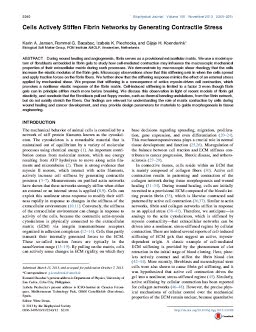2013-11-19
Cells actively stiffen fibrin networks by generating contractile stress
Publication
Publication
Biophys. J. , Volume 105 - Issue 10 p. 2240- 2251
During wound healing and angiogenesis, fibrin serves as a provisional extracellular matrix. We use a model system of fibroblasts embedded in fibrin gels to study how cell-mediated contraction may influence the macroscopic mechanical properties of their extracellular matrix during such processes. We demonstrate by macroscopic shear rheology that the cells increase the elastic modulus of the fibrin gels. Microscopy observations show that this stiffening sets in when the cells spread and apply traction forces on the fibrin fibers. We further show that the stiffening response mimics the effect of an external stress applied by mechanical shear. We propose that stiffening is a consequence of active myosin-driven cell contraction, which provokes a nonlinear elastic response of the fibrin matrix. Cell-induced stiffening is limited to a factor 3 even though fibrin gels can in principle stiffen much more before breaking. We discuss this observation in light of recent models of fibrin gel elasticity, and conclude that the fibroblasts pull out floppy modes, such as thermal bending undulations, from the fibrin network, but do not axially stretch the fibers. Our findings are relevant for understanding the role of matrix contraction by cells during wound healing and cancer development, and may provide design parameters for materials to guide morphogenesis in tissue engineering.
| Additional Metadata | |
|---|---|
| Elsevier/ Cell Press | |
| doi.org/10.1016/j.bpj.2013.10.008 | |
| Biophys. J. | |
| Organisation | Biological Soft Matter-Former Group |
|
Jansen, K., Bacabac, R. G., Piechocka, I. K., & Koenderink, G. (2013). Cells actively stiffen fibrin networks by generating contractile stress. Biophys. J., 105(10), 2240–2251. doi:10.1016/j.bpj.2013.10.008 |
|
